The theoretical foundations of the Nakiela dynamic test
In 1892 Ewald proved that the crests of the ampullae of the semi-circular canals possess constant, automatic activity which he named the labyrinthine tension. This bioelectric activity is transmitted onto the entire musculature of the body, maintaining its tension, i.e. tonus. After the destruction of one labyrinth in a frog, Ewald recorded a voltage rise of adductors and flexors in the limb on the opposite side and the lack of tension of rectifiers and abductors in the limb on the side of the damaged labyrinth. Almost hundred years later this information of Ewald's was used by Nakiela (1) for creating the dynamic test, useful in the otoneurological diagnostics for differentiation of peripheral and central injuries. Today we already know that this automatic bioelectric activity of labyrinths is transmitted onto the somatic muscles of the body not directly to the spinal cord, but through the cerebellum (2, 3). Therefore, the resting activity of the labyrinth results in a vestibulo-cerebello-ophthalmic reflex and a vestibulo-cerebellospinal reflex. The Nakiela dynamic test investigates spontaneous vestibulo-cerebellospinal reflexes. Maintaining the correct bodily equilibrium at rest, in the physiological conditions depends on the symmetrical basic activity of both labyrinths and on the symmetrical efficiency of the cerebellar hemispheres. In the physiological conditions the resting bioelectric stimuli, coming from both labyrinths to the efficient cerebellar hemispheres, cause that the upper limbs outstretched forward with closed eyes stay still and do not diverge. I will explain this phenomenon based on the original figure no.7, which was presented during the habilitation lecture
.
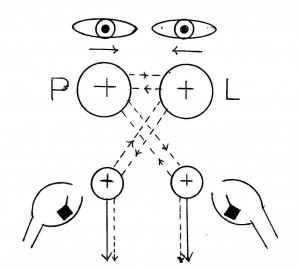 |
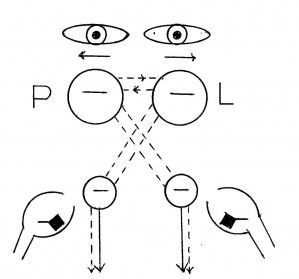 |
| 0 cm 0 cm | 0 cm 0 cm |
Fig. 7
Fig. 7 Man, S. J., aged 32. The equilibrium system efficient. The results of the vestibulo-cerebello-ophthalmic reaction and the vestibulo-cerebellospinal reaction after symmetrical caloric stimuli in the Ruttin test were recorded in 180" after finishing the administration of the stimulus.
a) 280ml - 44°C - 40"
b) 280ml - 20°C - 40"
Fig. 7a shows symmetrical stimulation of labyrinths with a warm stimulus. In both labyrinths the kinocilium was bent towards the utricle. Stimuli coming from the right labyrinth to the left cerebellar hemisphere cause its stimulation. The stimulation of the left cerebellar hemisphere causes nystagmus to the right and the adduction of the right upper limb. Simultaneous stimulation of the left labyrinth with a warm stimulus causes stimulation of the right cerebellar hemisphere, which results in nystagmus to the left and the adduction of the left upper limb. It can be observed that the vectors of these powers act in opposite directions, are equal and neutralize each other. Therefore, neither nystagmus nor deviation of the upper limbs are observed.
Figure 7b shows a diagram of simultaneous stimulation of labyrinths with cold water. In both labyrinths the kinocilium was bent towards the canal. Stimuli coming from the labyrinths to the cerebellar hemispheres cause their symmetrical inhibition. The vectors of these powers also act in opposite directions, are equal and neutralize each other. Therefore, no nystagmus deviation of the upper limbs are observed, either. However, in the physiological conditions during symmetrical stimulation of labyrinths with a warm stimulus, the adduction of both upper limbs can be observed, as it was presented in Figure No. 8. This picture was also presented in the habilitation lecture.
.
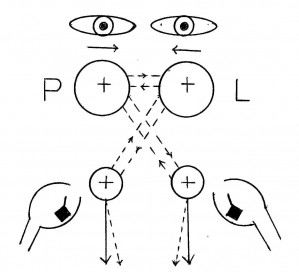 |
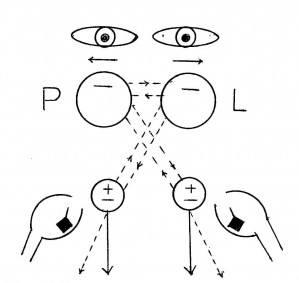 |
| 4 cm 4 cm | 10 cm 10 cm |
| a | b |
Fig. 8
Fig. 8. Patient (female), K.T., aged 23. The equilibrium system efficient. The Ruttin test was used - 280ml - 44°C - 40". A vestibulo-cerebello-ophthalmic reaction and a vestibulo-cerebellospinal reaction were recorded in 80" (and) and in 180" (b) after finishing the administration of the caloric stimulus.
a) the first phase of reflexes - stimulation of the cerebellar hemispheres.
b) the second phase of reflexes - inhibition of the cerebellar hemispheres.
It is visible that after the symmetrical stimulation of labyrinths with a warm stimulus we can obtain yje adduction of the upper limbs (in this instance by 4 cm). However, in the second phase, while inhibiting the cerebellar hemispheres, the symmetrical abduction of the upper limbs by 10 cm can be observed. No nystagmus reaction was recorded. The destruction of the cerebellar hemisphere with the symmetrical activity of the labyrinths causes the abduction of the upper limb on the side of the healthy cerebellar hemisphere. Such a reaction model in a person with the efficient equilibrium system can be caused by using the Ruttin test with an asymmetric cold caloric stimulus - fig. 1. This is an original picture which was presented as first in the habilitation lecture.
.
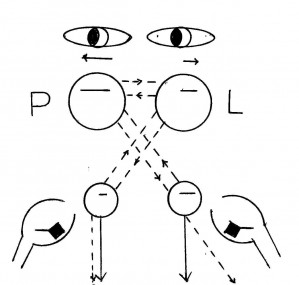 |
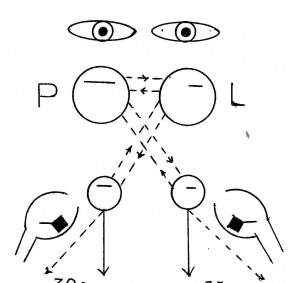 |
| 0 cm 25 cm | 30 cm 35 cm |
| a | b |
Fig. 1
Fig. 1. Patient (female), M. E., aged 21. The equilibrium system efficient. The Ruttin test with the asymmetric caloric stimulus was used: UP - 230 mls - 20°C - 40". Ul - 280 ml - 20°C - 40".
a) reaction in 100" from the end of the stimulus
b) reaction in 210" from the end of the stimulus
A bigger stimulus with cold water to the left ear caused a bigger inhibition of the right cerebellar hemisphere, which resulted in nystagmus to the right and the abduction of the left upper limb to the left. The adduction of the right upper limb is prevented by the inhibited left cerebellar hemisphere. Such a picture of vestibulo-cerebello-ophthalmic reflexes and vestibulo-cerebellospinal reflexes is observed during the destruction of the right cerebellar hemisphere. After the extinction of nystagmus there occurred the abduction of the right upper limb to the right, and a further abduction of the left upper limb to the left (fig. 1b). In healthy people, with exorbitant vestibulo-cerebellospinal reflexes, one observed the abduction of the limbs to the angle of 180°. Bilateral inhibition of the cerebellar hemispheres with a cold stimulus caused an image of limbs diverging, which is similar to that observed in dogs after the experimental removal of the cerebellum (fig. 2).
Fig. 2. The results of the destruction of the entire cerebellum (at the top) and the vermis only (below). (Andre - Thomas, according to Walsh).
A similar picture of the asymmetric abduction of the upper limb can be obtained by using smaller quantities of water and a shorter time of pouring - fig. 3a. We avoid then the phenomenon of vestibular adaptation to a higher degree.
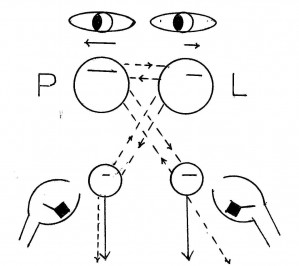 |
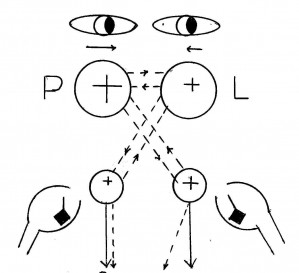 |
| 0 cm 13 cm | 0 cm 10cm |
a b
Fig. 3
Fig. 3. Patient (male), J. J., aged 50. The equilibrium system efficient. Calorific tests - asymmetric stimulus:
a) UP - 10ml - 20°C - 5". UL - 100ml - 20°C - 20".
b) UP - 10ml - 44°C - 5". UL - 100ml - 44°C - 20".
Vestibulo-cerebello-ophthalmic reactions and vestibulo-cerebellospinal reactions were recorded at 170" after finishing of using the caloric stimulus. A bigger quantity of cold water poured into the left ear causes a bigger inhibition of the right cerebellar hemisphere, which triggers nystagmus to the right and the abduction of the left upper limb to the left. The adduction of the right upper limb is prevented by slight inhibition of the left cerebellar hemisphere. Figure 3b shows the result of the vestibulo-cerebello-ophthalmic reaction and the vestibulo-cerebellospinal reaction after asymmetric stimulation of labyrinths with water with the temperature of 44°C. More intensive stimulation of the left labyrinth causes bigger stimulation of the right cerebellar hemisphere, which results in nystagmus to the left and the adduction of the left upper limb. The abduction of the right upper limb is prevented by slight stimulation of the left cerebellar hemisphere. The reactions which were obtained in the vestibulo-cerebellospinal reflexes, shown in figures 3a and 3b, are similar to those which are obtained in the Nakiela dynamic test, the pendular marking time test in ill persons with the destruction of the right cerebellar hemisphere (4) and in ill persons with the destruction of the right labyrinth (1). In ill persons with the destruction of the right cerebellar hemisphere in the author’s own test one observes a rotation to the right during the performance of the test with the left lower limb moved forward and the lack of rotation with the right lower limb moved forward. However, during the destruction of the right labyrinth in the author’s own test one observes a rotation to the right during the performance of the test with the left lower limb moved forward and the lack of rotation with the right lower limb moved forward. I am also presenting a pattern of vestibulo-cerebello-ophthalmic reactions and vestibulo-cerebellospinal reactions after symmetrical stimulation with cold stimulus in an ill person after removal of the tumor from the left cerebellar hemisphere (figure 14a), and a diagram of the same reactions after symmetrical stimulation with hot water, in an ill person after the destruction of the left labyrinth (figure 14b). These reactions are similar to those obtained during the research of spontaneous vestibulo-cerebellospinal reflexes in the author’s own test. Figure 14 was also presented in the habilitation lecture
.
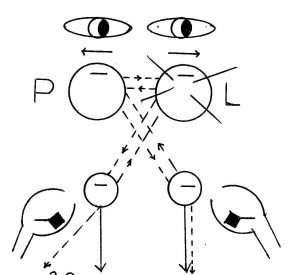 |
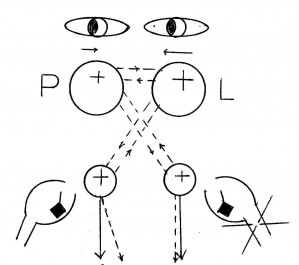 |
| 20 cm 0 cm |
6 cm 0 cm |
a b
Fig. 14
Fig. 14.
a) Patient D.E., aged 37. The state after surgery of the tumor of the left cerebellar hemisphere 10 years ago. Spontaneous nystagmus to the left with closed eyes is recorded. The excitability of labyrinths in the Fitzgerald-Hallpike test - symmetrical. The Torok test found "vestibular decruitment" in the right ear, the indicator - 0,9. The Ruttin test - 280ml - 20°C - 40". The reaction recorded at 90" after finishing the administration of the caloric stimulus.
b) Patient S.A., aged 40. Canal paresis on the left side. Spontaneous nystagmus with eyes closed was not found. The present positional nystagmus to the right in the position on the left side. The Ruttin test -280ml - 44°C - 40". The reaction recorded in 90" after finishing of using the caloric stimulus. The theoretical foundations of the author's dynamic test in peripheral injuries of the labyrinth after the performed habituation and the reversal of vestibulo-cerebellospinal reflexes were discussed in the chapter on "vestibular habituation".
I would like to come back for a while to the textbook "Clinical Otoneurology" edited by G. Janczewski, to which I have often been referred. I am going to present how this manual described spontaneous vestibulo-cerebellospinal reflexes in injuries of the labyrinth and to the destruction of the cerebellar hemisphere. These reflexes are called vestibulospinal reflexes and not vestibulo-cerebellospinal reflexes. Bień (5), in the chapter "The syndromes of peripheral and central destruction of the vestibular organ", says that in vestibular injuries in the past pointing test and deviation test both upper limbs to an equal degree deviate towards the damaged labyrinth. In the following information concerning the destruction of the cerebellar hemisphere the author says - quotation: "The ataxia in the walking test or deviation in the past pointing test of only one limb also weigh in favor of the destruction of the cerebellar hemisphere". This information does not tell us which upper limb deviates and which way. Kubiczkowa (6), while presenting the past pointing test by Barany, says - quotation: "In vestibular injuries there appears passing of both arms to the side of the free phase of nystagmus. In the destruction of the cerebellum only one hand deviates to the side of the focus". The presentation of the deviation test informs us - quotation: "In peripheral injuries the deviation of arms appears on both sides towards the free phase of nystagmus. In central injuries there appears an unilateral deviation of the arm towards the side of the focus".
In conclusion I remind once again that during the destruction of the labyrinth and the cerebellar hemisphere on the same side, e.g. right, we observe the following spontaneous vestibulo-cerebellospinal reflexes. During the destruction of the labyrinth we observe the adduction of the left limb towards the damaged labyrinth. The right limb remains still. After the destruction of the right cerebellar hemisphere we observe the abduction of the left limb to the left. The right limb remains in still. I should recall here my earlier observations concerning the investigations of ill persons with injuries of the peripheral vestibular organ by means of the Mann test. The ill persons had evident problems with maintaining the equilibrium with the lower limb moved forward on the side of the damaged labyrinth (often falling onto the side of the damaged labyrinth). However, with the lower limb moved forward on the side of the healthy labyrinth the examined person could better maintain equilibrium because the tendency to fall on the side of the damaged labyrinth could counteract (block) by means of the lower limb moved forward on the side of the healthy labyrinth (7). These observations can be used in the diagnostics of peripheral injuries of the vestibular organ.
REFERENCES
1. Nakiela J.: Study of the usefulness of the modified Unterberger test in determining efficiency of the equilibrium system. Doctoral thesis. £ód¼, Military Medical Academy, 1978.
2. Barany R.: Some new methods for functional testing of the vestibular apparatus and the cerebellum. Nobel Lecture, September 11, 1916.
3. Nakiela J.: The vestibulo-cerebellar system according to the latest investigations and interpretation of the author. Lecture at the examination for the degree of assistant professor. £ód¼, Military Medical Academy. 1990.
4. Nakiela J.: Study on the efficiency of the equilibrium system following lesions of the cerebellar hemispheres (clinical study). £ód¼, Military Medical Academy 1990.
5. Bień S.: Syndromes of peripheral and central destruction of the vestibular organ. The textbook Clinical Otoneurology edited by G. Janczewski. Warsaw, 1986. PZWL.
6. Kubiczkowa J.: Statokinetic tests. The textbook: Clinical Otoneurology edited by G. Janczewski, Warsaw 1986. PZWL.
7. Nakiela J.: Estimation of the sensitized Romberg test in the peripheral lesions of the vestibular organ. Medical News 1987, 40, 730-733.
The habilitation lecture was evaluated in voting by a secret ballot. So, the Medical Faculty Council of the Military Medical Academy in Lodz, based on my scientific achievements, my habilitation thesis, my habilitation colloquium and my habilitation lecture adopted a resolution to confer the degree of habilitated doctor on me. I was congratulated on this occasion by the Dean of the Medical Faculty Col. Prof. Jan Goch M.D., Ph.D. (SEE THE VIDEO).
VIDEO
The Medical Faculty Council of The Military Medical Academy accepted my scientific discoveries in its entirety.
Whoever would like to challenge these discoveries would have to provide a content-related justification. I must admit that I was happy and proud that I succeeded in bringing this entire difficult and complicated process to such an end. The documents connected with the habilitation qualification - (the habilitation thesis, 3 reviewers' opinions, 10 copies of scientific papers, questions and answers from the course of the habilitation colloquium, my habilitation lecture) were all sent from the Military Medical Academy within a month to the Central Commission for scientific degrees. In compliance with the regulations in force the Central Commission was obliged to confirm or refuse to confirm the Resolution of the Medical Faculty Council of the Military Medical Academy in Lodz within six months. A whole year had passed and I received no answer. It was not until 1992 that I received a message that the Central Commission had refused to confirm the Resolution of the Medical Faculty Council of the Military Medical Academy (WAM) based on the opinion by the reviewer of the Central Commission which also I received. I will present now the full text of the opinion by the Central Commission reviewer, Prof. Grzegorz Janczewski, M.D., Ph.D.